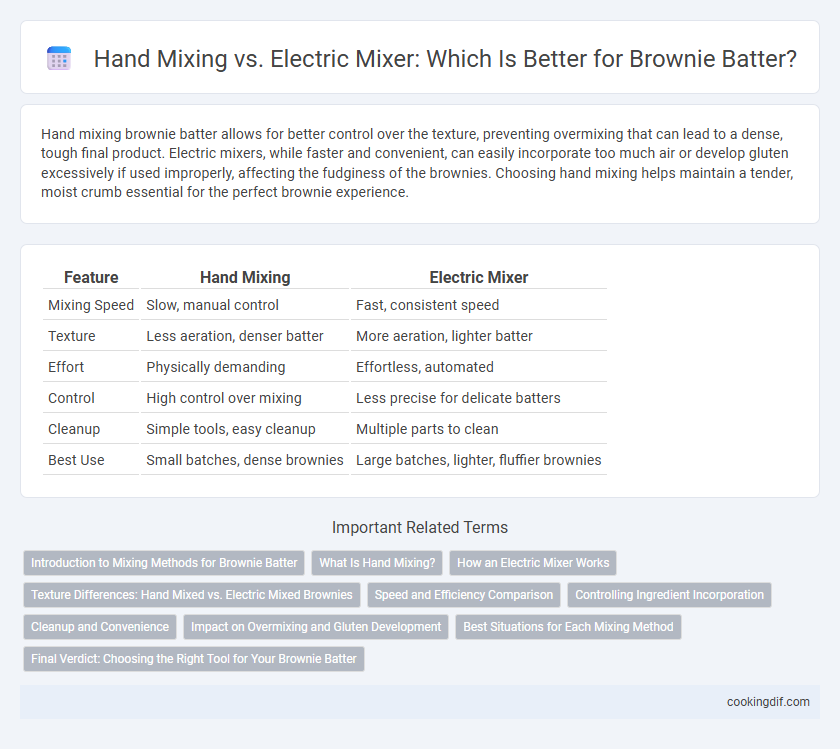Hand mixing brownie batter allows for better control over the texture, preventing overmixing that can lead to a dense, tough final product. Electric mixers, while faster and convenient, can easily incorporate too much air or develop gluten excessively if used improperly, affecting the fudginess of the brownies. Choosing hand mixing helps maintain a tender, moist crumb essential for the perfect brownie experience.
Table of Comparison
| Feature | Hand Mixing | Electric Mixer |
|---|---|---|
| Mixing Speed | Slow, manual control | Fast, consistent speed |
| Texture | Less aeration, denser batter | More aeration, lighter batter |
| Effort | Physically demanding | Effortless, automated |
| Control | High control over mixing | Less precise for delicate batters |
| Cleanup | Simple tools, easy cleanup | Multiple parts to clean |
| Best Use | Small batches, dense brownies | Large batches, lighter, fluffier brownies |
Introduction to Mixing Methods for Brownie Batter
Hand mixing brownie batter allows for greater control over texture, ensuring a denser, fudgier consistency by gently combining ingredients without over-aeration. Electric mixers, while faster and more efficient, can introduce excess air into the batter, potentially resulting in a lighter, cakier brownie texture. Choosing the appropriate mixing method impacts the final crumb and overall moistness of the brownies.
What Is Hand Mixing?
Hand mixing involves using a whisk, spoon, or spatula to manually combine brownie batter ingredients, allowing for greater control over texture and consistency. This method minimizes over-mixing, which helps maintain the desired fudgy or cakey brownie structure by preventing excessive gluten development. Hand mixing also reduces the risk of incorporating too much air, resulting in denser, richer brownies compared to those made with an electric mixer.
How an Electric Mixer Works
An electric mixer uses a motor to rotate beaters, quickly and evenly combining ingredients to create smooth brownie batter. The consistent speed and power reduce mixing time while avoiding overmixing, which can affect brownie texture and rise. This efficient mechanical action ensures uniform batter consistency, essential for rich, fudgy brownies.
Texture Differences: Hand Mixed vs. Electric Mixed Brownies
Hand mixing brownie batter typically yields a denser, fudgier texture due to gentler incorporation of ingredients, preserving small air pockets. Electric mixers introduce more air, resulting in lighter, cakier brownies with a fluffier crumb. Choosing hand mixing or an electric mixer directly influences the final moisture and texture profile of the brownies.
Speed and Efficiency Comparison
Hand mixing brownie batter offers greater control but requires more time and physical effort, typically taking 5 to 10 minutes depending on the recipe and mixer skill. An electric mixer can complete the same task in 1 to 3 minutes, providing consistent speed and thorough mixing, which prevents overmixing and results in a uniform batter texture. For large batches or frequent baking, using an electric mixer optimizes efficiency and reduces preparation time significantly.
Controlling Ingredient Incorporation
Hand mixing allows precise control over ingredient incorporation, preventing overmixing and maintaining the fudge-like texture essential for brownies. Electric mixers can quickly overwork the batter, leading to denser, cakier results by developing excess gluten. Opting for hand mixing ensures a tender crumb and rich, moist consistency characteristic of classic brownies.
Cleanup and Convenience
Hand mixing brownie batter results in minimal cleanup, requiring only a bowl and a whisk, making it highly convenient for quick preparation. Electric mixers involve more components such as beaters and splatter shields that need washing, increasing cleanup time. For those prioritizing ease and efficiency post-baking, hand mixing offers a streamlined experience without sacrificing batter quality.
Impact on Overmixing and Gluten Development
Hand mixing brownie batter offers greater control, significantly reducing the risk of overmixing and excessive gluten development, which can cause a tough, dense texture. Electric mixers, while faster, tend to incorporate more air and can overwork the gluten, leading to a chewier brownie. For optimal fudgy results, gentle hand mixing ensures a tender crumb by limiting gluten activation.
Best Situations for Each Mixing Method
Hand mixing offers precise control over batter texture, ideal for delicate brownie recipes requiring a light, airy crumb or when incorporating chunky add-ins like nuts or chocolate chips. Electric mixers excel in quickly achieving a smooth, uniform batter, perfect for dense, fudgy brownies or when preparing large batches to save time and ensure consistent mixing. Choosing the method depends on desired brownie texture and recipe complexity, with hand mixing favored for subtle control and electric mixers for speed and efficiency.
Final Verdict: Choosing the Right Tool for Your Brownie Batter
Hand mixing allows precise control over the batter's texture, preventing overmixing and resulting in fudgier brownies with a dense crumb. Electric mixers provide speed and ease but risk incorporating excess air, which can lead to cakier, less dense brownies. For achieving the perfect brownie texture, hand mixing is the optimal choice to maintain desired moisture and richness.
Hand mixing vs electric mixer for batter Infographic

 cookingdif.com
cookingdif.com